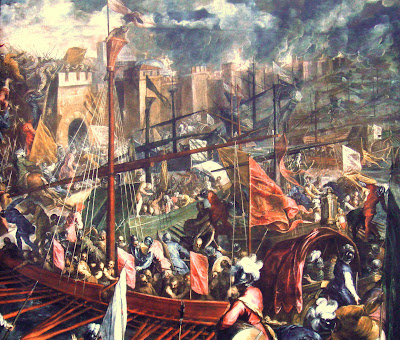
After a siege that lasted exactly 53 days, the Turks conquered Byzantium (today’s Istanbul) on May 29, 1453. With this conquest, an era that had lasted 1,000 years in history also closed.
The young Sultan, who took the title of Fâtih (The Conqueror) with this unparalleled victory and was only 21 years old, entered the city shortly after 8:30 AM. It was past 10 o’clock when he reached the Hagia Sophia. Green and red Turkish flags were fluttering in the prominent parts of the city. Only at Bahçekapı were Cretan sailors still trying to resist the Turks. The fighting had ended in the other neighborhoods. The heroism shown by the Cretans greatly pleased the Conqueror. He allowed these sailors not to be taken captive but to board their ships with their weapons and sail to Crete.
A crowd of nearly 50,000 people filled the Hagia Sophia. According to the understanding of the Middle Ages, this crowd was the fruit of victory: anything could be done to them.
When the Conqueror of Eastern Rome appeared in the Hagia Sophia, everyone, including the Patriarch, prostrated themselves. They pleaded and begged for forgiveness. The Turkish Khan signaled with his hand, silencing them.
“Arise,” he said. “I tell you all that, as my subjects, you no longer need fear my wrath for your lives or your freedom.”
These words heralded a new era, a new understanding… Sultan Mehmed II, who became Sultan at the age of 12 and conquered Byzantium at the age of 21, was a valuable scholar as well as a good soldier.
PREPARATIONS FOR THE CONQUEST OF BYZANTIUM
When Sultan Mehmed II ascended the throne for the second time on February 3, 1451, upon the death of his father, he ordered the construction of a massive fortress across from the Anatolian Fortress (Anadolu Hisarı) built by his great-grandfather Yıldırım. This was the narrowest point of the Bosphorus.
With the completion of this structure—where even viziers carried stones to encourage the workers—the Bosphorus came completely under Turkish domination. As the name Boğaz Kesen (Cutter of the Strait) given by Mehmed II suggests, the Fortress was built to cut across the strait and dominate the passage from sea to sea. This important and strategic passage, which had been open until that time, thus came under the control of the Turks. Meanwhile, the Anatolian Fortress was also repaired. Cannonballs fired mutually from these fortresses would not allow any ship to sail between the Black Sea and Marmara without permission.

Sultan Mehmed II considered developing the cannon, which was very primitive in those days, and increasing its caliber in order to demolish the walls of Byzantium. He commissioned Hungarian Urban, the most skilled artilleryman of the era whom he took on, to cast cannons in Edirne. He had test shots conducted. These cannons were powerful enough to destroy the world’s largest fortresses. One of them, in particular, was enormous. It was transported from Edirne by 60 buffalo and with the help of 400 soldiers and brought to the front of Constantinople (Istanbul) within February. In early March, it was placed at a location 5 miles away from the city walls (across from Eğrikapı). The roads over which the cannon would pass had been repaired beforehand by 50 masters and 200 workers.
Karaca Bey, who had captured Misivri, Ahyolu, Vize, Bigados, and Yeşilköy belonging to Byzantium and besieged Silivri, was tasked by the Sultan with transporting this cannon. Among the weapons deemed suitable for use in the siege were flying flaming bombs. These bombs were intended to be thrown over the walls and dropped inside the city.
Sultan Mehmed II, who besieged Byzantium on April 6, adjusted the position of the batteries and regulated them based on the five-day siege experience on April 11. On April 18, the islands were captured. On the night of April 22, the miracle of transporting the Turkish fleet of 67 small ships overland and launching them into the Golden Horn was achieved. This event, which crushed all Byzantine hopes, happened as follows: The Turkish fleet was spotted by the Byzantines as it crossed the hills and ridges at night and approached the Golden Horn. But the Byzantine fleet in the Golden Horn could do nothing due to the fire opened by Zağanos Pasha from the slopes of Kasımpaşa. The launching of the light Turkish fleet into the Golden Horn thoroughly bewildered the Byzantines. A portion of the army that had been defending the land walls until then was assigned the task of defending the Golden Horn walls. After the Byzantine attempt to burn the Turkish fleet in the Golden Horn failed, the Turks bombarded the Byzantine and Genoese ships in this inner sea with cannonballs using mortars placed on the ridges of Beyoğlu and Kasımpaşa, sinking all of them.
After the Turkish fleet became free in the Golden Horn, a wide wooden bridge was built between Kasımpaşa and Unkapanı by bringing barrels and rafts side-by-side. The Byzantines were unable to burn this bridge either, and the Turks also besieged Byzantium from the Golden Horn.

Leave a Comment